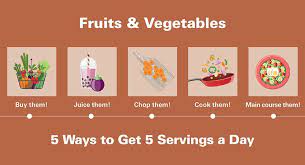BLOGS FOR MEN

Include AT LEAST 5 Portions of Fruit and Vegetables in your diet DAILY
Why?
Fruit and vegetables should be the cornerstone of our diets given that they are valuable sources of essential vitamins and minerals that we need to consume daily (read about functions and benefits from the list below). In addition, they’re a good source of fiber, a food component that often gets overlooked for its numerous health benefits. Although fruit is important, ideally the emphasis should be on vegetables, which should make up at least 3-4 of the 5 portions we need to achieve each day. In addition to being nutrient rich, fruit and vegetables are low in calories, whilst the high fiber levels to help keep you fuller for longer, so they’re an integral part of any body transformation program.
Ensuring you’re eating a VARIETY is also key. If you have the same fruits and vegetables day-in and day-out then you’re consuming the same profile of micronutrients all of the time rather than taking advantage from the vast array of nutrients on offer when you start to include new foods into your diet. Just to emphasize how important this is, Imperial College in London analyzed 95 studies on fruit and vegetable intake and concluded that consuming above 5 portions of fruit and vegetables per day showed major benefits in helping to reduce the chance of suffering a heart attack, stroke, cancer and early death!
But what’s in them that makes them so beneficial? Here’s a run down of some of the main vitamins and minerals found in fruit and vegetables:
Vitamin C - important for maintaining healthy body tissues by protecting them from damage, it also helps with the formation of collagen needed for the healthy formation of bones, gums, teeth and skin. It’s required for the normal functioning of the immune system as well as supporting the liver and our detoxification system. Also note that vitamin C is also water soluble, meaning we cannot store it in our bodies and therefore consuming foods containing vitamin C at each meal is crucial for keeping our levels topped up.
Sources: Citrus fruits, strawberries, papaya, kiwi, green vegetables, peppers and tomatoes. In fact, most fruits and vegetables will contain some level of vitamin C!
Vitamin A - particularly important for eye health, the immune system and maintenance of the skin and internal linings of some parts of the body e.g. the digestive system. Most people tend to lack Vitamin A in their diets.
Sources: Liver, eggs, dark green leafy vegetables, orange colored fruits and vegetables (carrots, oranges, cantaloupe melons, orange peppers, papaya).
Folate - helps blood cells to form and function properly, which is crucial for the delivery of oxygen around the body. It also supports the normal functioning of the immune system and is fundamental for energy production, therefore helping to reduce tiredness and fatigue.
Sources: Dark green leafy vegetables, peas and beans, oranges, berries and fortified foods.
Potassium - Supports the normal functioning of the nervous system and is critical in maintaining normal blood pressure and water balance in the body.
Sources: bananas, blackcurrants, avocado, spinach, parsnip, beetroot, poultry, fish, milk and wholegrain cereals.
Can we not just supplement?
It’s best to focus on foods first, this lays the foundations for a healthy, balanced diet. Fresh fruit and vegetables also contain phytochemicals, which work together as part of the whole food to help fight the onset and progression of numerous diseases, including cancer. And we shouldn’t forget fiber, which has been connected with the prevention of type 2 diabetes, heart disease and of course can help manage constipation.
How to include 5 or more portions a day
At least 1-2 portions of fruit or veg should feature at each of your main meals per day. You could also utilize them in snacks. Here are some tips to upping your fruit or vegetable intake at each meal or snack:
Try adding a handful of spinach to a morning smoothie for some extra greens
Swap your morning fruit juice for a piece of fruit. Although seemingly healthy, fruit juices are high in sugar. Our recommendation is to eat a piece of fruit over having juice as the fibre from eating the fruit will help to keep you fuller for longer. Alternatively, as part of a snack you may want to try a vegetable based juice. These contain many vitamins and minerals without having the added sugar from fruit.
Make snack times count - swap out energy bars for vegetable crudités and hummus, a smoothie or vegetable based juice.
Make a batch of stewed apples (simply chop them up with the skin on, boil them in a little water for 10 mins, add a sprinkle of cinnamon to taste and blitz in a blender). Add it to yoghurt, porridge or add into smoothies for some extra sweetness.
Load up any home-made dishes with chopped vegetables. For example, add some mushrooms and grated carrots into bolognese, peas and sweetcorn into some cooked rice, or pad a curry out with red peppers, mushrooms and spinach. Get creative, you can slot vegetables into your cooking anywhere!
Chop and roast a bunch of your favorite vegetables to serve as a side for your meal. You could always chop extra vegetables and put them in the freezer so they’re ready to roast if you’re short of time.
Side salads go a long way too boosting your vegetable intake, plus, they’re easy to throw together with whatever vegetables you have left in the fridge.
Frozen fruits and vegetables count too! Often frozen varieties of foods are freshly picked and frozen straight after so they retain their nutritional status. Frozen vegetables are also easy to store and last for longer making them an easy addition to meal times. Frozen fruits meanwhile can be added to smoothies.
Try including one new fruit and vegetable per week. Our bodies love different strains of fibers found in a wide selection of fruit and vegetables to promote better digestive health. In addition it means you expose yourself to a greater selection of beneficial vitamins and minerals.
Try using a fruit and vegetable delivery box service. Usually the items included are seasonal too, they come with recipe ideas and it solves the issue of making sure you’re getting varied sources of fruit and vegetables.
Get creative! The internet is brimming with recipes to help with inspiration. The key is to aim to have 1-2 portions of fruit and/or vegetables at each meal so they become a staple part of the diet.
Further Reading:
1. Eating more fruits and vegetables may prevent millions of premature deaths: https://www.imperial.ac.uk/news/177778/eating-more-fruits-vegetables-prevent-millions/
2. British Nutrition Foundation, fruits and vegetables: https://www.nutrition.org.uk/healthyliving/healthydiet/fruit-and-vegetables.html?limit=1&start=2
3. Supplement vs Whole Foods: https://www.mayoclinic.org/healthy-lifestyle/nutrition-and-healthy-eating/in-depth/supplements/art-20044894
Beat The Dad Bod USA
10531 E Northwest HWY
(469) 949-5765
support@beatthedadbodusa.com
NOT FACEBOOK™: This site is not a part of the Facebook™ website or Facebook Inc. Additionally, This site is NOT endorsed by Facebook™ in any way. FACEBOOK™ is a trademark of FACEBOOK™, Inc.
We use cookies, including third-party cookies, on this website to help operate our site and for analytics and advertising purposes. For more on how we use cookies and your cookie choices, go here for our cookie policy!
Legal and Regulatory Earnings and Results Disclaimer
“The financial information, strategies, and projections provided on our website, products, or services are intended for educational and informational purposes only. Past performance is not indicative of future results, and individual success may vary. We cannot guarantee that you will achieve similar outcomes or results by following the information, advice, or strategies shared on our platform. We are not responsible for any financial decisions or actions you take based on the information provided. It is your responsibility to conduct your own research and consult with a qualified financial professional before making any investment or financial decisions.
Our company disclaims any liability for losses or damages that may arise directly or indirectly from the use or reliance on the information provided. By using our website, products, or services, you agree to assume all risks associated with such use and to release our company, its affiliates, and partners from any claims, damages, or liabilities that may arise from your financial decisions.”
Testimonial Disclaimer
“The testimonials presented on our website, products, or services reflect the individual experiences of our customers and are provided for illustrative purposes only. They are not intended to guarantee, promise, or represent that all customers will achieve the same or similar results. Individual results and experiences may vary, and the outcomes mentioned in the testimonials should not be considered typical or standard. Our company does not verify the accuracy or authenticity of the testimonials, and they should be viewed as subjective opinions provided voluntarily by our customers. We cannot assure that every customer will have a similar experience or achieve the same level of satisfaction. By using our website, products, or services, you acknowledge and agree that our company is not responsible for any decisions or actions you take based on the testimonials provided.”

